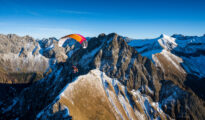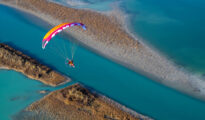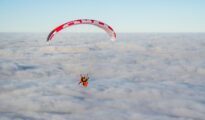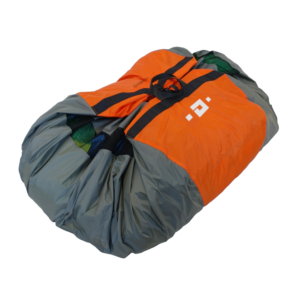Solo
Solo
Solo is a beginner and intermediate reflex paraglider for single place fun/XC flying with a paramotor or a light trike. It's design allows for safe gathering experience at thermalling.
It is robust, stable and offers good lift.

Design and purpose
Both the design and advantages have evolved from the renowned tandem trike wing – the Cabrio. Solo offers a coherent & stable canopy, creating quite a lot of lift. All parameters have been selected to maintain the right proportions of passive safety, performance, and ease & precision of steering.
Solo will meet the expectations of both recreational and XC pilots. It provides security of the typical B-category wings level.
Launch
During the start, Solo fills and gets up willingly, with no tendency to lag or overtake. The entire launch takes place over a relatively short distance, at low speeds. The use of launch-assisting tapes is usually not necessary. We recommend starting with the trimmers fully engaged.
 See movie
See movie
Flight
Solo is stable with good lift. Looks good at moderate speeds, but equally efficiently moves forward when you need to accelerate. The elements of reflex and Shark Nose protect your safety, while the general flight chracteristics and light controls make for effective use of encountered lift.
Variable airfoil geometry, adjustable with trimmers, allows you to adjust the airfoil shape to the current flight profile and precisely control the flight speed.
Solo features a dual control system. The main steering lines work similarly to the classic wings and can be used throughout the full range of the trimmer. Small TST handles are used mainly in accelerated flight (open trimmers). Such a system makes it easier for the pilot to control and increases the efficiency of making turns without putting much effort in it.
In turbulence, the wing behaves predictably and confidently, efficiently suppressing both lateral and front-rear swings.
Landing
During landing approach, a relatively small pullon the brakes is enough to significantly reduce the speed and land gently.
Solo and its “classmates”
The question arises about the differences between Solo and similar wings in this segment – the Universal 1.1 or the no longer produced Synthesis 2. The Solo is more refined due to its slightly increased aspect ratio (5.4, as compared to 5.1 in Universal and Synthesis), yet at the same time it is easier to use. However, its “genes” come more from the Orca side, in particular the Cabrio, a fact emphasized by the same graphic design (with a modified color system).
Compared to Synthesis, Solo gets up and launches easier. In flight, its controls are lighter, and pilot will get a better feel of the air when thermalling. It is also more economical and has wider take-off weight ranges.
The Universal is, according to its name, more universal, while Solo is a pleasant, thoroughbred paramotor wing for beginner and intermediate pilots looking for an uncomplicated wing for fun and cross-country flying. The Solo has a shorter trimmers than Universal, and risers are easier to operate.
 See movie
See movie
Design
- The canopy has been designed in our CSG system (Canopy Shape Guard), which consists of several subsystems guaranteeing exceptional coherence of the canopy shape and its extended durability.
- Adjustable reflex airfoil of the paraglider is based on our flagship DRA concept (Dudek Reflex Airfoil), duly optimized using special CFD software.
- The intakes of Shark-nose technology
- The Solo is made with the Flexi-Egde technology – the precise shape of the leading edge is kept with laminated cloth reinforcements, incorporating synthetic rods. These rods considerably improve launch quality, as well as keep deformations away at high speeds.
- Careful selection of modern fabrics and design solutions brings about maximum reliability, strength and durability. All materials come from numbered production batches, and each production step can be verified down to identification of specific worker and controller.
The Solo is manufactured in technology utilizing precision of the laser cutter. All stages of production process take place in Poland under strict supervision of the designer himself, thus ensuring highest European quality.
Design solutions, technologies and other functionalities are listed below in the Technologies section.
Construction solutions
Technologies, concepts
Risers functionality
Used solutions
Parameters
Weight ranges

TECHNICAL DATA
| Name – size |
Solo 18 | Solo 21 | Solo 24 | Solo 27 |
| Approval – ULM identification | – | yes | yes | yes |
| Number of cells | 53 | |||
| Wing area flat [m2] | 18.00 | 21.00 | 24.00 | 27.00 |
| Wing area projected [m2] | 15.30 | 17.86 | 20.41 | 22.96 |
| Wingspan flat [m] | 9.86 | 10.65 | 11.38 | 12.07 |
| Wingspan projected [m] | 7.84 | 8.47 | 9.05 | 9.60 |
| Aspect ratio flat | 5.4 | |||
| Aspect ratio projected | 4.02 | |||
| Sink rate [m/s] | min = 1.2; (+/- 0.2 m/s) | |||
| Speed* [km/h] | min = 23, trim = 39-50; max = 61 (+/- 3 km/h)* | |||
| Distance pilot to wing [m] | 5.91 | 6.39 | 6.83 | 7.24 |
| Total line lenght [m] | 298,82 | 323,67 | 346,81 | 368,53 |
| Canopy weight [kg] | 4.39 | 4.83 | 5.28 | 5.72 |
| Take-off weight** [kg] | 50-85** | 60-100** | 80-130** | 100-160** |
| Max take-off weight – for experienced*** [kg] | 105*** | 125*** | 160*** | 200*** |
| Distance between risers [cm] | 45 | 45 | 45 | 45 |
| Load test [kg] | 288 kg at 5.25 G | |||
| Lines | A-8000U: 050 / Technora: 90; 140; 190; 280; 340 / Dyneema: 350 | |||
| Cloth | Porcher Sport 38 g/m2 Dominico Tex 34 g/m2 Porcher Hard Finish 40 g/m2 SR-Scrim, SR Laminate 180 g/m2 |
|||
* Speeds are given as estimated for the middle wing size and the middle of its weight range. These speeds can vary within +/- 3 km / h depending on the size, take-off weight and additional factors such as air pressure and temperature.
** The basic rule is to choose the size of the wing so that the take-off weight is in the middle of the weight range. Less weight on the wing (lower range take-off weight) can be considered for foot take-off, when flying in calmer conditions, or when we want to improve economy. More experienced pilots who want to fly dynamically, have higher speed and fly in more demanding wind conditions can consider greater wing loading (take-off weight in the upper range). This is a common option among trike users.
*** Note – the canopy significantly changes its behavior with increasing wing loading. The greater the loads, the greater skill and concentration of the pilot are required.













































